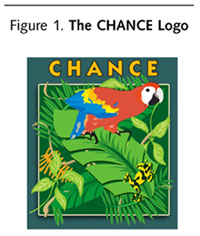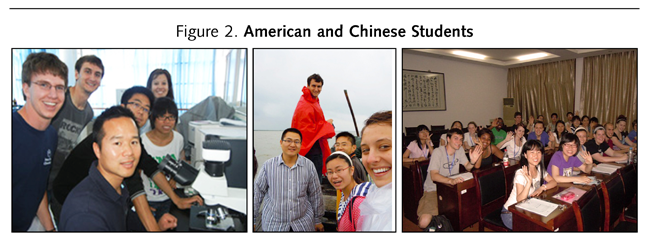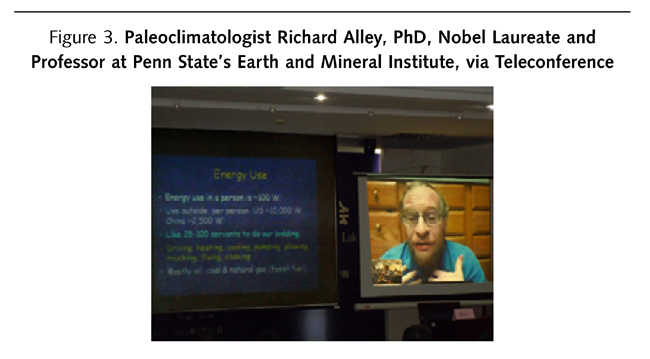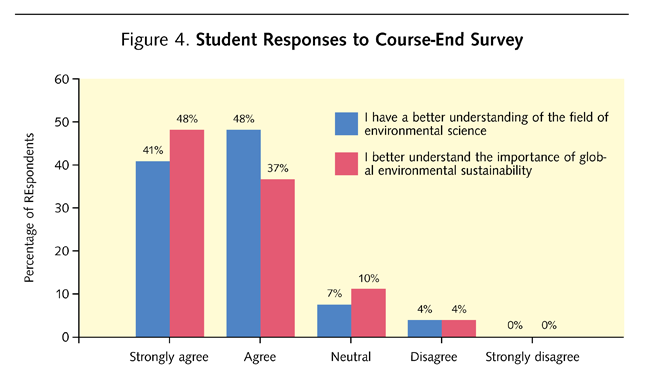Case Study 11: The CHANCE Program in China: Transforming Students into “Global-Minded†Scientific Investigators and Citizens
- Published:
- Books and Monographs
- Author(s) and Contributors:
-
Author(s): Jackie McLaughlin
- Source(s) and Collection(s):
-
Sources(s): EDUCAUSE Publications
- ParentTopics:
Abstract
A case study from Game Changers
Jacqueline McLaughlin
Introduction
The Risk
America's position in the world may once have been reasonably secure with only a few exceptionally well-trained men and women. It is no longer.
—National Commission on Excellence in Education, A Nation at Risk
For more than twenty-five years, U.S. educators, researchers, and policy makers have bemoaned the nation's dearth of highly qualified college graduates pursuing meaningful careers in science and technology, warning against a corresponding loss of U.S. economic, scientific, and technological supremacy in the world.1 Numerous national reports and research findings indicate colleges need to respond, particularly in the STEM (science, technology, engineering, and mathematics) majors. By reducing science education to spontaneous, drill-and-practice paradigms centered around lectures, most college programs are sacrificing quality for the sake of "covering" quantity.2 However, it is possible for science educators to create learning environments that foster conceptual understanding, interdisciplinary content, authentic scientific experience, and interpersonal skills that will increase the heterogeneity of students who are attracted to scientific fields and who can feel the allure of experimental science and the thrill of discovery. The end result—a scientifically literate society and a reinvigorated research enterprise—could be far-reaching. It could even be revolutionary.3
Recently, the National Science Foundation (NSF) and the American Association for the Advancement of Science (AAAS) implemented a national call for immediate transformation in U.S. undergraduate biology education:
Champion more engaging and relevant biology education, both to society and to the natural world; and, foster the skills to address the challenges of the 21st century, including the ability to think like a scientist and to contribute outside disciplinary boundaries.4
Technology can help create learning environments in which scientific concepts, research, and real-world issues come to life—by linking students with researchers in authentic situations—to transform students into proactive, well-rounded, global-minded scientific investigators and citizens. And, when it comes to environmental education especially, environments and biomes cross national borders and must be viewed and studied from a global perspective.
CHANCE in China
The CHANCE model provides students with this much-needed environmental global perspective, by bringing students directly to the science.
CHANCE (Connecting Humans And Nature through Conservation Experiences, http://www.chance.psu.edu/) is a Penn State educational outreach and professional development program whose overarching goal is to educate undergraduates and K–12 science teachers and their students in conservation biology and global environmental sustainability by engaging students in real-world research opportunities in global environments. Besides learning essential core concepts and research skills, participants also gain the awareness, knowledge, and skills needed for a more sophisticated comprehension of the causes, connections, and consequences of global environmental destruction.5
For example, the reality of global urbanization and industrialization is impacting an important life-sustaining resource, water—especially in China. Through a CHANCE embedded field course (http://www2.lv.psu.edu/jxm57/explore/china2011/), both Penn State University and China's Jiangnan University students recently addressed this problem
The course format unites Penn State undergraduate students across disciplines (science, agriculture, engineering, liberal arts, and international affairs) with their Chinese counterparts (http://www2.lv.psu.edu/jxm57/explore/china2010/photoalbum2010/index.html) to examine the impact of burgeoning development upon one of China's crucial water resources, Lake Taihu. In 2007, the lake was designated a "natural disaster" when pollution (effluents such as phosphorus and nitrogen from an estimated 1,300 nearby factories) resulted in a major algae outbreak.6 A two-week practicum challenged twenty-eight students and ten faculty members to examine firsthand the effects of industrial, municipal, and urban development within the Taihu basin—one of the most industrialized regions in China—and to offer strategic solutions for the lake's restoration.

The group conducted cooperative experiments on the water quality of, and land use around, Lake Taihu to improve its awareness of environmental problems and learn sampling and analysis methods used to diagnose aquatic ecosystem health and stability. After the chemical, biological, and physical characteristics were analyzed, the results were disturbing: Lake Taihu's nutrient levels continue to indicate a eutrophic state and therefore anything coming out of the lake is unsafe for human consumption. To fully evaluate the local, provincial, national, and international ramifications of the group's field research findings, faculty members, technical experts, government leaders, business leaders, and noted American and Chinese scientists fielded questions from students about how to balance the economic and environmental health of the area. Together, they also visited local algal salvage plants, as well as industrial and wastewater treatment plants.
Students then delivered summative group research reports on the water quality and sustainability of Lake Taihu, including experimental design, implementation, and data interpretation.

The students' findings clearly indicate that more waste and industrial water-treatment facilities are warranted, as is enhanced environmental education to promote a more knowledgeable and responsible citizenry. And, restoration efforts presently in place (blue-green algae salvage ships, dredging lake bottom, factory relocation, artificial floating beds, introduction of algae-eating fish, water transferring via Yangtze River tributaries, restoration of riparian buffers) are, cumulatively, helping to lessen the eutrophication process. But, as of September 2011, algal blooms continued to threaten both the health of the lake and its water quality, deemed undrinkable.7
Technology as the Catalyst
Technology catalyzed every aspect of this and all other CHANCE field courses, beginning with the course planning and execution—from designing field-research activities and building an itinerary in China to e-mail blasts promoting the course to students, to online applications, Facebook, and CHANCE's own website. Travel and agenda logistics also required technological assistance—especially setting up and conducting a two-day international conference on the "Water Environment and the Ecological Restoration of Taihu Lake" that included video (Skype) participation of key researchers (see Figure 3).

And, all CHANCE field courses use the Field Course Experiential Learning Model (http://chance.psu.edu/exp-learning-model.html), which features three steps:
- online pretrip assignments that provide essential background knowledge;
- a field-based trip experience that includes conservation work; journal keeping; inquiry-based research on a real-world environmental issue; participation in discussion groups, lectures, panel discussions, and formal research presentations; and independent exploration; and
- posttrip online assignments that encourage the integration and application of key concepts learned, all posted in advance through Penn State's course management system (ANGEL) and later submitted via the same from learners all over the world.8
Finally, we recorded video in the field and during the final student presentations and group-panel discussion forums for later use in grading student academic performance, public relations pieces, and development of future CHANCE courses.
Evidence of Effectiveness
In addition to their final course projects, all students completed a fifteen-question course-end survey, providing details about their real-life experiences. Their trip journal and posttrip questions/reflections served as additional qualitative data. As with previous CHANCE assessments, survey results suggest these highly motivated students returned home with much more than a stamp in their passports (see Figure 4).

Working in the field also inspired students to engage in future environmental field research: 89 percent agreed or strongly agreed that the Lake Taihu project motivated them to engage in global environmental stewardship activities. "We got to do the investigation by ourselves and to get data and suggestions from the local people," one student commented. "It was real, not in our textbooks or lecture notes."
One student explained, "I want to break language barriers and understand other cultures so that I can do more research in other places like we did here in China." Another student put it this way: "If we learn from the mistakes of the past, developing nations could avoid causing future environmental problems for themselves in the future. This motivates me to work toward sustainability in my country and all over the world."
Student Reflections
"Reading books on the eutrophication and water pollution issues helped me learn the basics, but it was the international speakers that really made me understand how vital our research was."
Michelle O., Penn State biology major
"What was revealed beyond the data gathered was the importance of addressing global environmental concerns together."
William B., Penn State engineering major
Challenges for the Future
This course exemplifies how international courses in colleges may use technology as a catalyst to create environments that foster and deliver conceptual understanding, interdisciplinary content, authentic scientific experience, and interpersonal skills in order to increase the heterogeneity of students who come to appreciate and understand science, and who use experimental science as a means to bettering society as we know it.
We need to work more efficiently and productively with academics, researchers, economists, nongovernmental and governmental officials, and businesses worldwide. We need to bring the students to the science, both virtually and physically, in order to educate them about the realities of our world.
Challenges related to funding, diplomacy, visas, and time zones are formidable, but nonetheless surmountable. It is time for colleges to not only implement NSF/AAAS's call for vision and change in biological education, but to do so by breaking out of traditional boundaries of didactic education. We need to invest institutional resources and partner with global academics to inspire globally minded students who feel empowered to define sustainable answers for life on Earth. Responding to these challenges with a "game-changer" such as detailed here may be our best CHANCE.
Acknowledgments
CHANCE thanks all its sponsors and partners—numerous academic institutions, scholarly societies, non-governmental and governmental organizations, and businesses worldwide. Together, we have created and continue to create educational environments that inspire individuals who work towards environmentally sustainable lifestyles and answers. CHANCE is also beholden to all those at The Pennsylvania State University who have been instrumental is providing oversight and direction for the CHANCE Program throughout the past years.
Notes
Epigraph: National Commission on Excellence in Education, A Nation at Risk: The Imperative for Educational Reform (Washington, DC: U.S. Department of Education, 1983), http://www2.ed.gov/pubs/NatAtRisk/index.html.
- Shirley A. Jackson, Envisioning a 21st Century Science and Engineering Workforce for the United States: Tasks for University, Industry, and Government (Washington, DC: The National Academies Press, 2003), http://www.nap.edu/openbook.php?isbn=0309088569; Members of the 2005 "Rising above the Gathering Storm" Committee, Rising above the Gathering Storm, Revisited: Rapidly Approaching Category 5 (Washington, DC: The National Academies Press, 2010), http://www.nap.edu/openbook.php?record_id=12999.
- Diane F. Halpern and Milton D. Hakel, "Applying the Science of Learning to the University and Beyond: Teaching for Long-Term Retention and Transfer," Change 35, no. 4 (2003): 37–41, http://www.csub.edu/tlc/options/resources/handouts/scholarship_teaching/HalpernHakel.pdf; Jo Handelsman, Diane Ebert-May, Robert Beichner, Peter Bruns, Amy Chang, Robert DeHaan, Jim Gentile, Sarah Lauffer, James Stewart, Shirley M. Tilghman, and William B. Wood, "Scientific Teaching," Science 304 (April 2004): 521–22, http://www.jstor.org/pss/3836701; Robert L. DeHaan, "The Impending Revolution in Undergraduate Science Education," Journal of Science Education and Technology 14, no. 2 (June 2005): 253–69, http://wikifuse.pbworks.com/f/DeHaan%2B2005.pdf.
- Vision and Change in Undergraduate Biology Education (2010), http://visionand change.org/finalreport.
- "Dr. Bruce Alberts' Message to Vision and Change," http://visionandchange.org/bruce-alberts/.
- Jacqueline McLaughlin and Kathleen Fadigan, "The CHANCE (Connecting Humans and Nature through Conservation Experiences) Program: Transitioning from Simple Inquiry-Based Learning to Professional Science Practice," in Exemplary Science Programs: Science for Resolving Issues/Problems, ed. Robert Yager (Arlington, VA: NSTA Press): 185–202; Jacqueline S. McLaughlin, "Reimagining Science Education and Pedagogical Tools: Blending Research with Teaching," EDUCAUSE Quarterly 33, no. 1 (2010), http://www.educause.edu/EDUCAUSE+Quarterly/EDUCAUSEQuarterly MagazineVolum/ReimaginingScienceEducationand/199386.
- Joseph Kahn, "In China, a Lake's Champion Imperils Himself," New York Times, October 14, 2007, http://www.nytimes.com/2007/10/14/world/asia/14china.html?pagewanted=all.
- Richard Stone, "China Aims to Turn Tide against Toxic Lake Pollution," Science 333, no. 6047 (September 2, 2011): 1210–11, http://www.sciencemag.org/content/333/6047/1210.summary.
- Jacqueline S. McLaughlin and D. Kent Johnson, "Assessing the Field Course Experiential Learning Model: Transforming Collegiate Short-Term Study Abroad Experiences into Rich Learning Environments," Frontiers: The Interdisciplinary Journal of Study Abroad 13 (November 2006): 65–85, http://www.frontiersjournal.com/documents/McLaughlinJohnsonFrontiersXIIIFall06.pdf.
Jacqueline McLaughlin is an Associate Professor of Biology at The Pennsylvania State University–Lehigh Valley Campus. She received her doctorate from Rutgers University and her master's degree from The Florida State University. She is an innovator in developing inquiry-based learning strategies, and she is the Founding Director of CHANCE (Connecting Humans And Nature through Conservation Experiences).
© 2012 Jacqueline McLaughlin